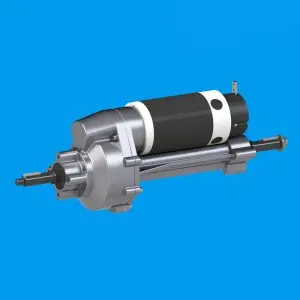When it comes to the mechanical components that control vehicle performance, the hydrostatic transaxle is a vital system. Although not widely known, this complex invention plays a vital role in enabling smooth navigation and maneuverability. In this blog post, we’ll take a closer look at the inner workings of a hydrostatic transaxle, exploring its components, functions, and highlighting its importance in today’s machinery.
Basic knowledge of hydrostatic transaxle:
A hydrostatic transaxle is a combination of a hydraulic transmission and axle. It acts as a bridge between the engine and the wheels, transmitting power and controlling speed. Unlike traditional mechanical transmissions that rely on gears to change speed and direction, hydrostatic transaxles use hydraulic fluid pressure to perform these functions. Simply put, it converts engine power into hydraulic pressure to create a seamless driving experience for a variety of vehicles.
Components of the hydrostatic transaxle:
1. Hydraulic pump: The hydraulic pump in the hydrostatic transaxle is responsible for converting the mechanical energy generated by the engine into hydraulic pressure. It drives the system and makes it work.
2. Hydraulic motor: The hydraulic motor is placed near the driving wheel, converts hydraulic pressure back into mechanical energy, and drives the wheel movement. It works in conjunction with the pump to complete the power transmission cycle.
3. Control valve: The control valve helps regulate the flow of hydraulic oil within the transaxle system. They determine the vehicle’s direction and speed by controlling the amount of hydraulic pressure sent to the hydraulic motor.
4. Hydraulic Fluid: Like any hydraulic system, a hydrostatic transaxle requires hydraulic fluid to operate effectively. Fluid helps smooth movement of hydraulic components, dissipates heat and provides lubrication.
working principle:
The working principle of a hydrostatic transaxle can be simplified into three key steps:
1. Power input: The engine generates mechanical energy to drive the hydraulic pump in the transaxle. As the pump spins, it pressurizes the hydraulic oil.
2. Pressure conversion: Pressurized hydraulic oil is directed to a hydraulic motor, which uses hydraulic pressure to generate rotational mechanical energy. This energy is transferred to the drive wheels, propelling the vehicle forward or backward depending on the direction of fluid flow.
3. Control and Regulation: Control valves within the transaxle system allow the operator to regulate the speed and direction of the vehicle. By regulating the flow of hydraulic oil to the hydraulic motor, the control valve determines the vehicle’s motion characteristics.
Importance of modern machinery:
Hydrostatic transaxles have become an integral part of a variety of machinery, including lawn tractors, forklifts, and even heavy construction equipment. Their ability to provide seamless, efficient power transfer coupled with ease of maintenance and improved control makes them the first choice for many applications.
in conclusion:
Understanding how a hydrostatic transaxle works helps you understand the complex and fascinating role it plays in modern machinery. By combining hydraulic and mechanical energy, this innovative system ensures smooth, precise operation, optimizing the performance of vehicles across a wide range of industries. So next time you’re maneuvering a lawn tractor or driving a forklift, take a moment to appreciate the hydrostatic transaxle working silently behind the scenes to make your job easier.
Post time: Nov-08-2023


